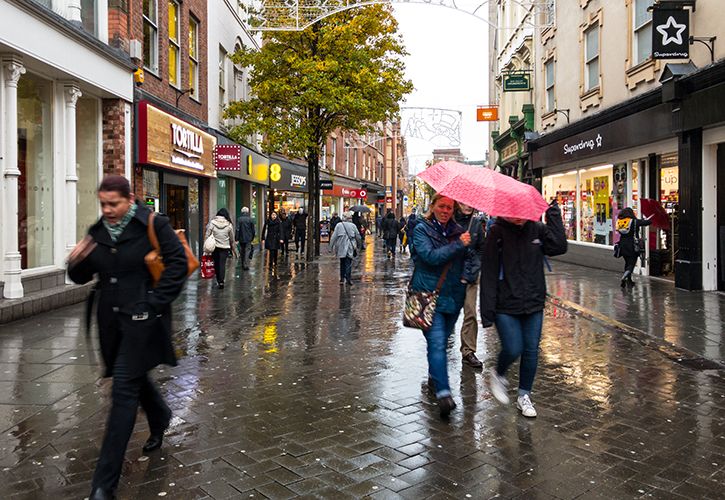UK DIY News
September Slump: Retail Footfall Declined And Consumer Confidence Fell

- Footfall fell by -3% from August to September in all UK retail destinations led by a -4.5% decline in high street footfall and less severe declines in shopping centres (-1.4%) and retail parks (-1.6%).
- Compared to 2023 levels, footfall in UK retail destinations rose marginally by +0.1% in September driven by a +2.6% rise in retail parks and a +0.5% rise in shopping centres. High street footfall fell by a modest -1.2%.
- Weekend footfall in UK’s retail destinations rose by +0.1% from August to September whereas weekday activity declined marginally by -0.4%.
- The back-to-school rush and widespread throughout September likely exacerbated footfall trends for the month, however still aligns with historical trends typically witnessed at this time of the year.
September typically marks a return to school and offices following the summer break and, as a result, retail footfall often sees a month on month decline. This year is no different with footfall levels declining by -3% in all UK retail destinations. However, it appears to have been exacerbated compared to previous September’s, likely due to the widespread flooding witnessed in the final week of the month across many parts of the UK.
High street footfall fell sharply by -4.5% in September from August which was probably worsened by two factors; the return to school and offices in the second week of the month and the turbulent weather witnessed in the final week of the month resulting in week on week declines of -8% and -4.2%, respectively. However, a boost in footfall of +4.9% during the penultimate week for high streets may well have coincided with many more employees returning to offices and settling into a routine. This was especially noticeable in regional cities outside of London (+9.6%) and office dense locations within the city, as measured by MRI Software’s Central London Back to Office benchmark (+6.8%), reflecting a much stronger return to office compared to this time last year.
Weekday footfall in UK’s high streets remained -1.2% lower compared with 2023 levels however a deeper dive revealed that Tuesday’s saw a +0.7% rise in footfall and is the first rise witnessed since March 2024 suggesting that the return to office is only just beginning and may well strengthen over the coming months. The greatest impact of the return to office appears to be reflected in regional cities outside of London where footfall during the weekday rose by +1.7% with Tuesday’s (+3.4%) and Friday’s (+4%) seeing the greatest year on year uplift. This may well be driven by the presence of key business hubs within certain regions.
Shopping centres and retail parks also witnessed month on month declines however these were much less severe with footfall declining by -1.4% and -1.6%, respectively. The month was bookended with rises in activity which is likely due to many consumers visiting retail destinations in the first week of the month for last minute back-to-school essentials, and then in the final week of the month which coincided with payday weekend. The three weeks in between saw footfall decline week over week as schools fully reopened and employees returned to offices.
Compared to 2023, footfall remained fairly stable with a -0.1% decline recorded across all UK retail destinations. Retail parks and shopping centres saw an uplift of +2.6% and +0.5% whereas high streets saw a -1.2% decline which is the first decline since 2019 and highlights the impact of the inclement weather conditions in the final week of the month.
September also saw consumer confidence, as measured by GFK, take its biggest setback since March, falling by seven points to -20. However, compared to this time last year, the index still remains seven points higher with much of the improvement around consumers’ outlook on personal finances over the last 12 months which remains nine points higher than September last year. This sharp drop in consumer confidence may well be attributed to concerns about the general economic situation over the next 12 months, with confidence sitting at -27 compared to -29 last year. With energy bills set to rise and uncertainty around the Autumn budget, consumer caution may well increase and should be monitored closely by retailers as preparations for the Golden Quarter get underway.
As retail leaders gear up for the Golden Quarter and look ahead to 2025, AI-driven insights are becoming a necessity. The ability to bring together data from multiple sources, including footfall benchmarks, lease management data and operational data such as facilities management and energy usage is transforming the way retailers approach strategic planning and decision-making. Holistic data enables improved forecasting, quicker responses to shifts in the market, and the opportunity to create more personalised consumer experiences through refined marketing strategies.
Source : MRI Software
Image : Jason Batterham / Shutterstock / 671551474
I find the news and articles they publish really useful and enjoy reading their views and commentary on the industry. It's the only source of quality, reliable information on our major customers and it's used regularly by myself and my team.











































